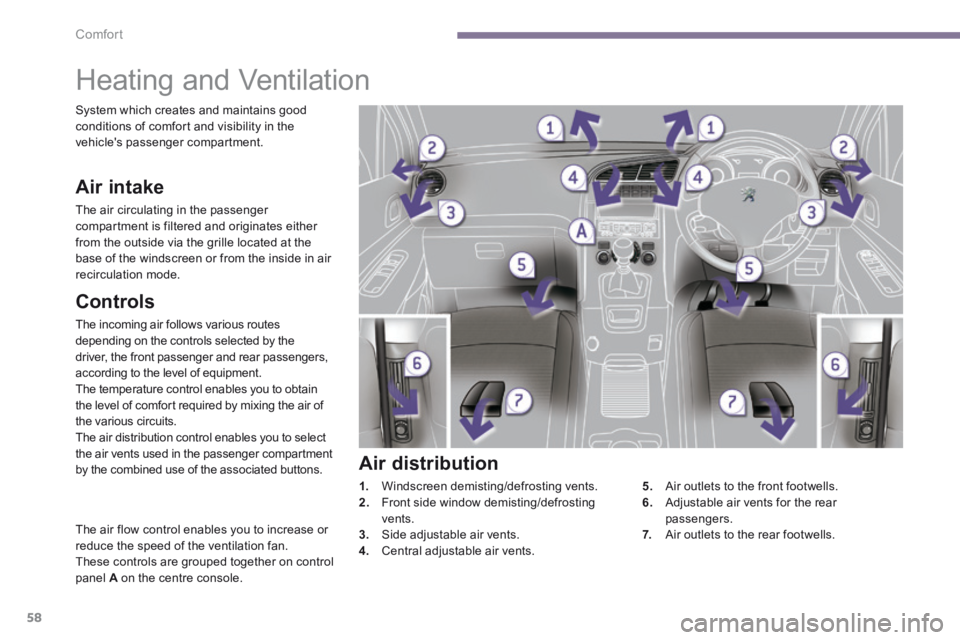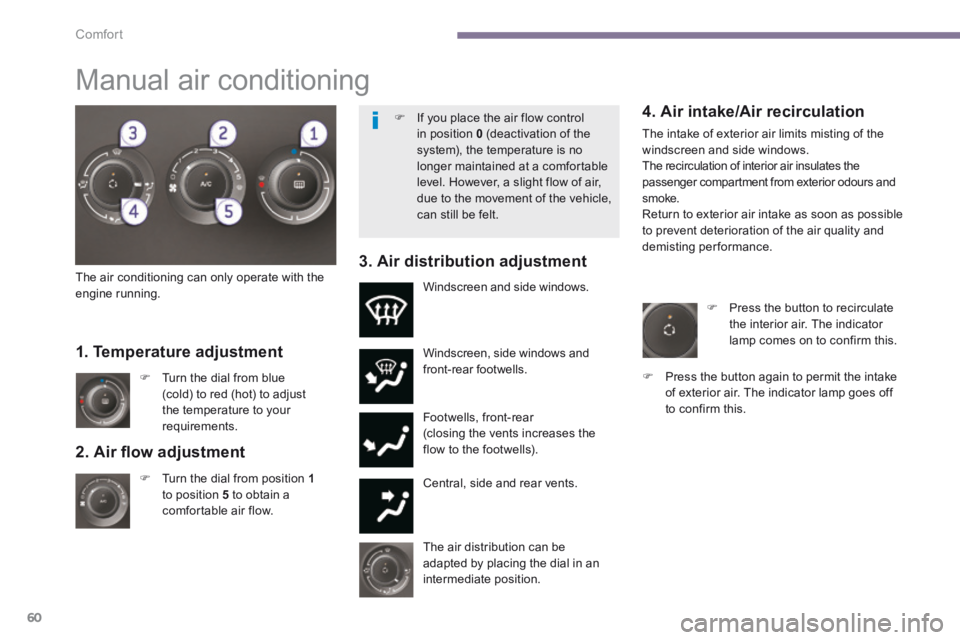2013.5 PEUGEOT 5008 window
[x] Cancel search: windowPage 4 of 404

.
.
Contents
Interior fi ttings 117Centre console 119Rear multimedia 122Panoramic sunroof 124Boot fi ttings 5 seat version 125Boot fi ttings 7 seat version 126
Fittings
Child seats 132Deactivating the passenger's front airbag 134ISOFIX mountings 144Child lock 151
Child safety
Instrument panels 27Indicator and warning lamps 30Indicators 39Adjustment buttons 43
Monitoring
Familiarisation
Screen A without audio equipment 44Screen A with audio equipment
46Screen C (PEUGEOT Connect Sound (RD5)) 4816/9 retractable colour screen (PEUGEOT Connect Navigation (RT6) or PEUGEOT Connect Media Navigation (NG4 3D)) 51Trip computer 54
Multifunction screens
Heating and Ventilation 58Manual air conditioning 60Rear screen demist - defrost 62Dual-zone digital air conditioning 63Front seats 66Rear seats, 2nd row 72Access to the 3rd row 74Rear seats, 3rd row 75Seat modularity 77Mirrors 78Steering wheel adjustment 80
Comfort
Remote control key 81Alarm 87Electric windows 89Doors 91Boot 94Fuel tank 96Misfuel prevention (Diesel) 99
Access
Lighting controls 100Daytime running lamps 104Automatic illumination of headlamps 106Headlamp adjustment 107Directional lighting 108Wiper controls 109Automatic rain sensitive wipers 112Courtesy lamps 114Interior mood lighting 115
Visibility
Eco-driving
Page 11 of 404

.Familiarisation9
Instruments and controls
1. Audio and telematic system steering mounted control stalk.
2. Steering lock and ignition.
3. Wipers / screenwash / trip computer control stalk.
4. Instrument panel.
5. Driver's airbag.
Horn.
6. Gear lever.
7. Electric parking brake.
8. 12 V accessory socket.
9. Centre console.
10. Panoramic sunroof control.
11. Handbook storage compartment.
12 . Manual headlamp adjustment. Instrument panel navigator associated with the PEUGEOT Connect Media PEUGEOT Connect Media PEUGEOT
Navigation (RT6).
13. Side switch panel.
14 . Door mirror controls. Electric window controls. Child lock.
15. Front door window demist/defrost vent.
16. Windscreen demist/defrost vent.
Page 19 of 404

.
163
159
151
Familiarisation17
Passenger safety
Passenger's front airbag
1. Insert the key. 2. Select the position: "OFF" (deactivation), with "rear facing" child seat, "ON" (activation), with front passenger or "for wards facing" child seat.
3. Remove the key keeping the switch in the new position.
Seat belts and passenger's
front airbag
A. Front and/or rear seat belts not fastened / unfastened warning lamp. B. Front left seat belt warning lamp. C. Front right seat belt warning lamp. D. Rear right seat belt warning lamp.
E. Rear centre seat belt warning lamp. F. Rear left seat belt warning lamp. G. Passenger's front airbag deactivated warning lamp. H. Passenger's front airbag activated warning lamp.
Electric child lock
Lighting of the indicator lamp indicates the status of the corresponding function. Locking of the rear doors and deactivation of the rear electric window controls.
7 seat version (3rd row)I. Rear right seat belt warning lamp. J. Rear left seat belt warning lamp.
Page 27 of 404

.Familiarisation25
Eco-driving
Optimise the use of your
gearbox
With a manual gearbox, move off gently and change up without waiting. During acceleration change up early.
With an automatic or electronic gearbox, give preference to automatic mode and avoid pressing the accelerator pedal heavily or suddenly.
The gear shift indicator invites you engage the most suitable gear: as soon as the indication is displayed in the instrument panel, follow it straight away. With an electronic or automatic gearbox, this indicator appears only in manual mode.
Drive smoothly
Maintain a safe distance between vehicles, use engine braking rather than the brake pedal, and press the accelerator progressively. These practices contribute towards a reduction in fuel consumption and CO2 emissions and also helps reduce the background traffic noise.
If your vehicle has cruise control, make use of the system at speeds above 25 mph (40 km/h) when the traffic is flowing well.
Remember to make use of equipment that can help keep the temperature in the passenger compartment down (sunroof and window blinds...). Switch off the air conditioning, unless it has
automatic regulation, as soon as the desired temperature is attained. Switch off the demisting and defrosting controls, if not automatic. Switch off the heated seat as soon as possible.
Switch off the headlamps and front foglamps when the level of light does not require their use.
Avoid running the engine before moving off, particularly in winter; your vehicle will warm up much faster while driving.
Eco-driving is a range of everyday practices that allow the motorist to optimise their fuel consumption and CO2 emissions.
As a passenger, if you avoid connecting your multimedia devices (film, music, video game...), you will contribute towards limiting the consumption of electrical energy, and so of fuel. Disconnect your portable devices before leaving the vehicle.
Control the use of your
electrical equipment
Before moving off, if the passenger compartment is too warm, ventilate it by opening the windows and air vents before using the air conditioning. Above 30 mph (50 km/h), close the windows and leave the air vents open.
Page 60 of 404

Comfort
58
Heating and Ventilation
Controls
The incoming air follows various routes depending on the controls selected by the driver, the front passenger and rear passengers, according to the level of equipment. The temperature control enables you to obtain the level of comfort required by mixing the air of the various circuits. The air distribution control enables you to select the air vents used in the passenger compartment by the combined use of the associated buttons.
The air flow control enables you to increase or reduce the speed of the ventilation fan. These controls are grouped together on control panel A on the centre console.
Air intake
The air circulating in the passenger compartment is filtered and originates either from the outside via the grille located at the base of the windscreen or from the inside in air recirculation mode.
Air distribution
1. Windscreen demisting/defrosting vents. 2. Front side window demisting/defrosting vents.
3. Side adjustable air vents. 4. Central adjustable air vents.
5. Air outlets to the front footwells. 6. Adjustable air vents for the rear passengers.
7. Air outlets to the rear footwells.
System which creates and maintains good conditions of comfort and visibility in the vehicle's passenger compartment.
Page 61 of 404

3
Comfort59
The air conditioning system does not contain chlorine and does not present any danger to the ozone layer.
Recommendations for ventilation and air conditioning
In order for these systems to be fully effective, follow the operation and maintenance guidelines below: If the interior temperature remains very high after the vehicle has been parked in the sun for a considerable time, first ventilate the passenger compartment for a few minutes. Place the air flow control at a sufficient level to provide an adequate renewal of air in the passenger compartment. To obtain an even air distribution, take care not to obstruct the exterior air intake grilles located at the base of the windscreen, the nozzles, the vents and the air outlets, as well as the air extractor located in the boot. Use in preference the intake of exterior air as prolonged use of the air recirculation may cause misting of the windows and side windows. Do not cover the sunshine sensor, located on the dashboard; this is used for regulation of the automatic air conditioning system. Operate the air conditioning system for 5 to 10 minutes, once or twice a month to keep it in good working order. Ensure that the passenger compartment filter is in good condition and have the filter elements replaced regularly (refer to the "Checks" section). We recommend the use of a combined passenger compartment filter. Thanks to its second special active filter, it contributes to the purification of the air breathed by the occupants and the cleanliness of the passenger compartment (reduction of allergic symptoms, bad odours and greasy deposits). The air conditioning uses power from the engine while operating. This results in an increase in the vehicle's fuel consumption. When towing at or near maximum capacity or on steep slopes in high ambient temperatures, switching off the air conditioning saves engine power and so improves towing capacity. Condensation created by the air conditioning results in a discharge of water under the vehicle when stationary, which is per fectly normal. To ensure correct operation of the air conditioning system, you are also advised to have it checked regularly. If the system does not produce cold air, do not use it and contact a PEUGEOT dealer or a qualified workshop.
Rear ventilation
adjustment
After pressing the "REAR" button, turn the adjustment dial of the rear side vents to decrease or increase the flow of air. Take care not to obstruct the side vents and the air outlets on the floor. To shut off the flow of air, close the vents and
set the dial to 0.
Page 62 of 404

Comfort
60
2. Air fl ow adjustment
Turn the dial from position 1to position 5 to obtain a comfortable air flow.
Windscreen, side windows and front-rear footwells.
Footwells, front-rear (closing the vents increases the flow to the footwells).
Central, side and rear vents.
Turn the dial from blue (cold) to red (hot) to adjust the temperature to your requirements.
Windscreen and side windows.
1. Temperature adjustment
The air distribution can be adapted by placing the dial in an intermediate position.
The air conditioning can only operate with the engine running.
4. Air intake/Air recirculation
The intake of exterior air limits misting of the windscreen and side windows. The recirculation of interior air insulates the passenger compartment from exterior odours and smoke. Return to exterior air intake as soon as possible to prevent deterioration of the air quality and demisting performance. 3. Air distribution adjustment
Press the button to recirculate the interior air. The indicator lamp comes on to confirm this.
Press the button again to permit the intake of exterior air. The indicator lamp goes off to confirm this.
Manual air conditioning
If you place the air flow control in position 0 (deactivation of the system), the temperature is no longer maintained at a comfortable level. However, a slight flow of air, due to the movement of the vehicle, can still be felt.
Page 63 of 404

3
Comfort61
Demisting/defrosting
5. Air conditioning On / Off
The air conditioning is designed to operate effectively in all seasons, with the windows closed.
It enables you to: - lower the temperature, in summer, - increase the effectiveness of the demisting in winter, above 3 °C.
Switching on
Press the "A /C " button, the button's indicator lamp comes on. The air conditioning does not operate when the air flow adjustment control 2 is in position " 0 ". To obtain cooled air more quickly, you can use recirculation of interior air for a few moments. Then return to fresh air intake. The marking on the control panel indicates the position of the controls to quickly demist or defrost the windscreen and side windows:
place the air intake control 4 in the "Exterior air intake" position (indicator lamp off), place the air distribution dial 3 in the "Windscreen position", place the air flow dial 2 in position 5
(maximum), place the temperature dial 1 in the red position (hot).
Switching off
Press the "A /C " button again, the button's indicator lamp goes off. Switching off may affect comfort levels (humidity, condensation).
With Stop & Start, when demisting has been activated, the STOP mode is not available.